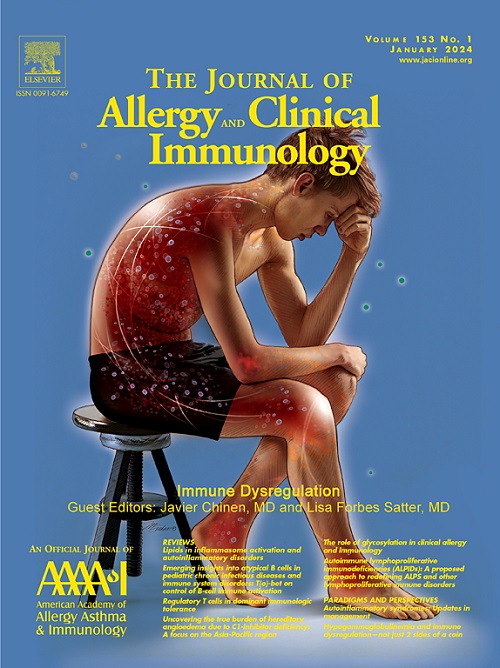气道和全身干扰素反应失调促进城市儿童哮喘恶化。
IF 11.4
1区 医学
Q1 ALLERGY
引用次数: 0
摘要
背景:确定为什么一些上呼吸道疾病引起哮喘加重仍然是一个未满足的需求。目的:鉴定与感冒进展到加重相关的转录组基因表达变化。方法:对208名6-17岁城市儿童(6-17岁)急性加重易感哮喘进行前瞻性监测,观察其是否有两种感冒疾病。加重性疾病(Ex+),定义为感冒导致哮喘加重,需要在10天内全身使用皮质类固醇,与无加重缓解的感冒(Ex-)进行比较。在基线和感冒期间收集外周血和鼻灌洗液样本进行RNA测序。比较干扰素基因在Ex+和Ex-疾病中的表达。广义加性模型揭示了干扰素反应动力学。多元线性回归模型比较干扰素表达与临床变量。结果:106名参与者在154次感冒期间接受了评估。与Ex-相比,Ex+疾病中差异表达的干扰素基因的上调幅度更大。Ex+疾病的干扰素表达平均值更高,上升幅度更大。在发病3天内,干扰素表达与鼻鼻病毒数量呈正相关(鼻:adjustedR2=0.48, p=0.015;血液:adjustedR2=0.22, p=0.013)和干扰素表达与预测FEV1 %负相关(鼻腔:β=-0.010, p=0.048;血:β= -0.008,p = 0.023)。干扰素基线表达水平较低的受试者发生哮喘加重的时间较短,病毒性疾病加重的风险较高,病毒性感冒期间干扰素表达水平增加较多(鼻:β=-0.80, p)。结论:干扰素反应失调是儿童哮喘加重风险的重要因素。在呼吸道疾病期间,低基线干扰素表达后气道和血液中干扰素通路的上调增加了恶化风险。针对高危人群的这一途径有望个性化预防哮喘恶化。本文章由计算机程序翻译,如有差异,请以英文原文为准。
Dysregulation of airway and systemic interferon responses promotes asthma exacerbations in urban children
Background
Determining why some upper respiratory illnesses provoke asthma exacerbations remains an unmet need.
Objective
We sought to identify transcriptome-wide gene expression changes associated with colds that progress to exacerbation.
Methods
Two hundred eight urban children (6-17 years) with exacerbation-prone asthma were prospectively monitored for up to 2 cold illnesses. Exacerbation illnesses (Ex+), defined as colds leading to asthma exacerbations requiring systemic corticosteroids within 10 days, were compared to colds that resolved without exacerbation (Ex−). Peripheral blood and nasal lavage samples were collected at baseline and during colds for RNA sequencing. Interferon gene expression was compared between Ex+ and Ex− illnesses. Generalized additive modeling revealed interferon response kinetics. Multiple linear regression models compared interferon expression to clinical variables.
Results
One hundred six participants were evaluated during 154 colds. There was greater upregulation of differentially expressed interferon genes during Ex+ illnesses compared to Ex−. Ex+ illnesses had greater average and steeper rise in interferon expression. Within 3 days of illness, interferon expression was positively associated with nasal rhinovirus quantity (nasal: adjusted R2 = 0.48, P = .015; blood: adjusted R2 = 0.22, P = .013), and interferon expression was negatively associated with percentage predicted forced expiratory volume in 1 second (nasal: β = −0.010, P = .048; blood: β = −0.008, P = .023). Participants with lower baseline interferon expression had shorter time to exacerbation, higher risk for exacerbation with viral illnesses, and greater increase in interferon expression during viral colds (nasal: β = −0.80, P < .0001; blood: β = −0.75, P < .0001).
Conclusion
Dysregulated interferon responses are important contributors to asthma exacerbation risk in children. Low baseline interferon expression followed by greater upregulation of interferon pathways in airway and blood during respiratory illnesses increased exacerbation risk. Targeting this pathway in at-risk individuals holds promise for the personalized prevention of asthma exacerbations.
求助全文
通过发布文献求助,成功后即可免费获取论文全文。
去求助
来源期刊
CiteScore
25.90
自引率
7.70%
发文量
1302
审稿时长
38 days
期刊介绍:
The Journal of Allergy and Clinical Immunology is a prestigious publication that features groundbreaking research in the fields of Allergy, Asthma, and Immunology. This influential journal publishes high-impact research papers that explore various topics, including asthma, food allergy, allergic rhinitis, atopic dermatitis, primary immune deficiencies, occupational and environmental allergy, and other allergic and immunologic diseases. The articles not only report on clinical trials and mechanistic studies but also provide insights into novel therapies, underlying mechanisms, and important discoveries that contribute to our understanding of these diseases. By sharing this valuable information, the journal aims to enhance the diagnosis and management of patients in the future.

 求助内容:
求助内容: 应助结果提醒方式:
应助结果提醒方式:


